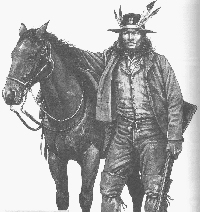"We boldly claim that we have done our duty, to the full extent of our power, as the friends and allies of the Federal Government. More than three fourths of the able bodied men of the loyal Cherokee, fought in the Federal army, which is a vastly larger proportion of men than any state in the Union has furnished for the war. We fought to the end of the war, and when the last rebel was whipped, we were honorably mustered out of the service.
The graves of eight hundred Cherokee warriors, fallen by our side in your service, testify that we have done our duty. Now, having done our whole duty to the Government, all we ask is that the Government do its duty to us -- that it fulfill its treaty obligations to us -- that it fulfill its solemn, reiterated pledges.
We ask no gifts, no charities, but simply our rights for which we have fought and bled in your armies, and for which so many of our noblest men have died. We make our earnest appeal to the President of the United States and to Congress. We entreat you to regard sacredly your past treaties with us, and to enact no law that shall sweep out of existence those most sacred rights which you have guaranteed to us forever."
The 1866 Cherokee Delegation: Smith Christie, James McDaniel, Thomas Pegg, White Catcher, Daniel Ross, John B. Jones, Samuel Benge
Native Americans were often overlooked in both armies. Perhaps because of the smaller numbers of them that served in the war effort. About 12,000 American Indians served in the army of the Confederacy and around 6,000 served in the Union army. Most of the Indians who served were members of the Five Civilized Tribes living outside of the Indian Territory.
Perhaps the best known of those in the Union Army was Colonel Ely Parker, who served as an aide to General U. S. Grant, and was present at Robert E. Lee's surrender at Appomattox Court House. Statistics for the Confederacy are not reliably available, but most scholars of Native American involvement in the actual fighting of the war are very well acquainted with the major Southern figure among them: Brigadier General Chief Stand Watie, a three-quarter blood Cherokee who was born in December 1806 near what would become Rome, Georgia.
Stand Watie was one of the signers of a treaty that agreed to the removal of the Cherokee from their home in Georgia to what was then the Oklahoma territory; this split the tribes into two factions, and Stand Watie became the leader of the minority party. At the outbreak of the Civil War, the minority party gave its allegiance to the Confederacy, while the majority party went for the North. Watie organized a company, then a regiment known as the First Cherokee Mounted Rifles; the regiment fought at Wilson's Creek, Elkhorn, and in numerous smaller fights and skirmishes along the border with what was known as Indian Territory.
 The warriors found curious the
white man's strategy of standing still and allowing people to shoot at them, or lob
artillery shells at them; the Cherokee tended to be spectacular at wildly brave mounted
charges, but once the artillery began to fire, the warriors wanted nothing to do with it.
Stand Watie was unreconstructed to the end; it is believed he never surrendered until June
23, 1865, well after other Confederate commanders had given up. He died in 1871 and is
buried in the Old Ridge Cemetery in Delaware County, Oklahoma.
The warriors found curious the
white man's strategy of standing still and allowing people to shoot at them, or lob
artillery shells at them; the Cherokee tended to be spectacular at wildly brave mounted
charges, but once the artillery began to fire, the warriors wanted nothing to do with it.
Stand Watie was unreconstructed to the end; it is believed he never surrendered until June
23, 1865, well after other Confederate commanders had given up. He died in 1871 and is
buried in the Old Ridge Cemetery in Delaware County, Oklahoma.
The Confederates would raise eleven regiments and seven battalions of Indian cavalry with a few more scattered throughout the ranks of white units. These Indians would go to battle with long hair, painted faces and their dress was mainly made up of their traditional Indian costumes. This included buck-skin hunting shirt, dyed of almost any color, leggings, and moccasins. Many went into battle bareheaded and about half carried only bows and arrows, tomahawks and war clubs. The natives were often ill-treated and ignored by their superiors. This often led native soldiers to give a half-hearted effort to the war cause. All too often the natives would ignore army regulations and fight in their old traditional ways. But they certainly lent color to the troops of the Confederacy and Union.
Source: The Civil War Society's "Encyclopedia of the Civil War."